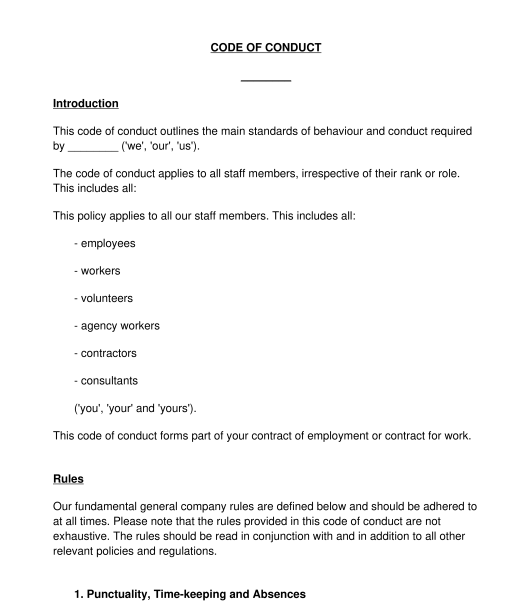 15/10/2025
15/10/2025

Answer a few questions and your document is created automatically.

Your document is ready! You will receive it in Word and PDF formats. You will be able to modify it.

 15/10/2025
15/10/2025
 Word and PDF
Word and PDF
 3 to 4 pages
3 to 4 pages
A workplace code of conduct is used by an employer to set out key rules and standards that will apply to all staff members. This workplace code of conduct can be used by employers in Great Britain.
A disciplinary procedure will set out how misconduct and disciplinary issues will be handled by an employer.
A code of conduct will explain any particular workplace rules and standards that are applicable to staff members. If the code of conduct is breached, it will lead to disciplinary action under a disciplinary procedure.
Yes, if any disciplinary rules/standards apply to a worker, they should be written down somewhere accessible, such as a policy document.
If an employer formally recognises a trade union or staff association, they may wish to consult or agree on the terms of the code of conduct with them. If a collective agreement* is in place between the employer and the relevant union or association it may be a legal requirement to:
A collective agreement is a written contract that is negotiated between a union and an employer on behalf of its union members.
Usually, senior members of staff will be responsible for finalising the code of conduct. This might include a senior manager or a director of a company.
The code of conduct can remain in place indefinitely but should be reviewed at regular interviews to ensure it is relevant and up-to-date. Usually, a code of conduct will be reviewed annually.
Once it has been approved by the relevant person (usually a manager or director), the code of conduct should be drawn to the attention of staff members. It should be kept in a readily accessible location for staff members to refer to. It should be provided to all new staff members with their contract for employment/contract for work.
The code of conduct is intended to form part of the contract for work/contract of employment of staff members. This means that staff members must ensure that they adhere to the rules and standards within the code.
If an individual staff member fails to comply with the rules set out within the code of conduct, they will be subjected to a disciplinary process. This could potentially result in written warnings or, in serious cases, dismissal.
This should be used in conjunction with a disciplinary policy.
An employer will usually have other policy documents which expand upon the rules and conduct requirements concerning particular issues such as:
A code of conduct will specify the general rules and expectations about:
The main legal provision that applies to a workplace code of conduct is the Employment Rights Act 1996.
General information can also be found on the ACAS website.
You fill out a form. The document is created before your eyes as you respond to the questions.
At the end, you receive it in Word and PDF formats. You can modify it and reuse it.
Guides to help you
Workplace Code of Conduct - Template - Word & PDF
Country: United Kingdom